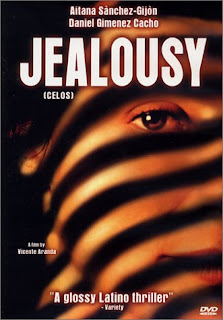In and around the small town community of Globe, Arizona, a series of brutal murders have been taking place with rich housewives being targeted by a maniac leaving elaborately staged crime scenes resembling ancient Apache rituals. After matching a set of tires found at one of the crime scenes, detective Charles Mendoza (Art Evans) becomes especially interested in Paul White (David Keith), a local family man and an installer of high-end audio equipment to a wealthy clientele. Joan (Cathy Moriarty), Paul’s loving wife of ten years doesn’t believe in the slightest that Paul has anything to do with the murders, however she has been suspicious of an infidelity and while dealing with one marital issue is confronted with a side of her husband she never thought imaginable.
Marketed as a serial killer film, very little of White of the Eye resembles any other film to fall under the serial killer umbrella. Although the murder investigation does play a major role in the film, White of the Eye is no police procedural, with Cammell using the concept of the serial killer as a springboard to bounce other ideas off of. The majority of the film centers around the relationship between Paul and Joan, cutting back and forth between the present as past (with the flashbacks bleached out in post giving them a highly contrasted look, an innovative technical move), establishing the evolution of their marriage with Joan’s former lover Mike also playing a huge role. Cammell makes exceptional use of the time spent with Paul and Joan, setting them up as the perfect couple, very much in love and great parents to a young daughter, however much like Hitchcock did with Shadow of a Doubt (1943) and Lynch with Blue Velvet (1986), the shattering of the perfect façade has ten times the impact once subsequent events begin to unfold and the film takes a turn for the psychotic, although in truth the film was off-center from the start with Cammell’s quirkiness giving the film a very peculiar sense of humor which oddly doesn’t at all clash with its moments of brutality. The cast of side characters are equally eccentric and although brilliant throughout the entire film, its during the films final third where Keith puts on a clinic, becoming thoroughly unhinged.
The film was co-written by Cammell and his wife China who also has a small role in the film. According to actor Alan Rosenberg who plays Joan’s former boyfriend Mike, the Cammell’s employed very curious casting techniques. Rosenberg recalls while auditioning actresses to the play the part of a murder victim who succumbs to drowning, the Cammell’s would actually repeatedly dunk the actresses heads in and out a bathtub. Its not the only case of China’s curious casting methods. In their essential book Donald Cammell: A Life on the Wild Side, biographers Rebecca and Sam Umland write that during the casting of what would ultimately become Cammell’s final film, Wild Side (1995), in order to be sure whomever was cast would be comfortable playing a lesbian, China would proceed to French kiss all the potential players. It wasn’t a very popular process. White of the Eye is also important in that it’s the only one of Cammell’s features that was more or less released with Cammell’s original vision completely intact, with no producer interference or editing woes unlike Performance, Demon Seed and Wild Side. Although it essentially disappeared as soon as it was released, the film is thankfully readily available and if any film is worthy of a bigger following, its White of the Eye. An absolute must watch for anyone interested in Cammell and for horror fans looking for something very different.





















